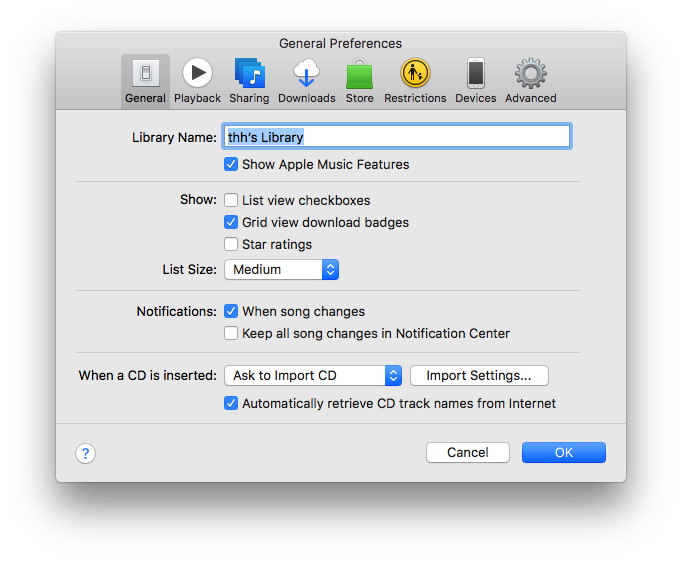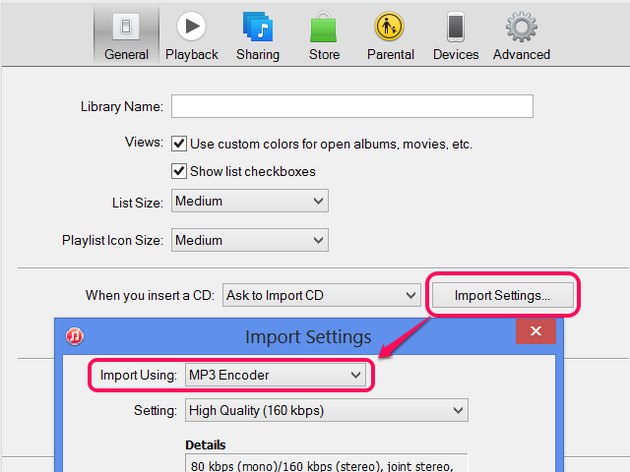

- #ITUNES MP3 ENCODER SETTINGS MOVIE#
- #ITUNES MP3 ENCODER SETTINGS ZIP FILE#
- #ITUNES MP3 ENCODER SETTINGS ARCHIVE#
- #ITUNES MP3 ENCODER SETTINGS FULL#
- #ITUNES MP3 ENCODER SETTINGS SOFTWARE#
You can play an MP3 file on almost any device. You are going to lose quality but save space. m4a but be careful not to confuse them with lossy AAC stuff purchased on iTunes as both share the same file extension.
#ITUNES MP3 ENCODER SETTINGS ZIP FILE#
ALAC can be thought to be some sort of zip file cutting the size of an original CD into half. This is my personal choice and I find it convenient on both Windows and Mac platforms. It can store CD-quality music in 16-bit format as well as 24-bit high-resolution tracks.

#ITUNES MP3 ENCODER SETTINGS FULL#
File sizes tend to be large due to being uncompressed.Īpple Lossless Encoder – Lossless encoder format also known as ALAC with full metadata support. AIFF can be used to store lossless audio in pure PCM format, however it supports no meta data which is a pain for properly tagging your music. I find it difficult to tell a decent AAC VBR file apart from their lossless counterparts – even on a good DAC.ĪIFF – Developed by Apple, AIFF is basically an uncompressed “file container” format and at home on a Mac. Combined with VBR you benefit from a better quality-to-space ratio. Although it’s still a lossy encoder, you can get pretty good sound quality out of it – especially in tandem with VBR (Variable Bitrate) encoding. Either convert your FLAC files to ALAC – this can be done with no loss of quality, or use something else to rip your CDs like Max (see above).ĪAC – Known as the successor to MP3 with better sound quality. Apple could break compatibility of these plugins with the next iTunes release. While you can add third-party plugins to make FLAC files at least playable, I don’t see a point here. On a side note, iTunes does not natively support the widely popular FLAC (Free Lossless Audio Compression) format. To round out my quick tutorial, let’s briefly go through the available Audio Encoders found in iTunes: Apple didn’t enable it by default because this feature could bog down older machines with less CPU horsepower.įigure 2: Here’s where we modify the actual encoder settings – pretty straightforward What this does is read error correction codecs from the disc to prevent audible glitches (pops and clicks). Make sure to check the box “Use error correction when reading Audio CDs”. Fortunately, there are no further settings :) I personally use “Apple Lossless Encoder”. Next, you get to choose the actual Audio Encoder. On the “General” tab next to the desired action associated with inserting a CD, click “Import Settings…”.įigure 1: First, we gotta tell iTunes what to do with your CDs To change iTunes default import settings in favor of a lossless audio encoder, open the iTunes main menu and hit “Preferences…”.
#ITUNES MP3 ENCODER SETTINGS ARCHIVE#
Getting the bits off your discs with a “lossless compression” encoder means you are getting exactly the same audio quality as on the original disc albeit at half the file size it would normally take to archive those tracks in WAV or AIFF.

But as I have explained in an earlier article, I’m not a huge fan of compression.

If you choose to import the CD into your library, iTunes does so at 256 kB/s AAC lossy compression. On Windows, I always recommend FreeRIP and Exact Audio Copy.īy default, iTunes will prompt you for the next steps you wish to have carried out once you insert a Compact Disc. It supports a whopping 20+ formats and lets you customise the entire ripping process to your needs.
#ITUNES MP3 ENCODER SETTINGS SOFTWARE#
Max is Open Source software so it won’t break the bank. If you want more flexibility – either to have a wider range of audio formats available (including FLAC, OGG or other rather more exotic derivates) – you might want to investigate Max, that is if you’re on a Mac of course. It should take no longer than 10 minutes to get it up and running with the correct settings for best quality. Mac users can even replace the core playback engine of iTunes with something “better sounding”.ĭespite being not so well integrated into Windows, I found iTunes more intuitive than other software – maybe because I’m just used to it, who knows.
#ITUNES MP3 ENCODER SETTINGS MOVIE#
In addition, nothing beats having a single app to sync my iPhone, calendar, movie and music library. Thus far we have never experienced any serious issues save for the occasional hickup. I can get iTunes to talk to our family’s iDevices. I enjoy the fact that it comes pre-installed and I don’t have to download something else (Yep, I’m lazy). After all, the whole point is to extract bit-perfect copies to our hard drives, right?įor me there’s a lot to like about iTunes – at least on a Mac. Although audiophiles often prefer to use a number of different programs for copying CDs to their music server library, I like to keep it simple and just use iTunes for that purpose.


 0 kommentar(er)
0 kommentar(er)
